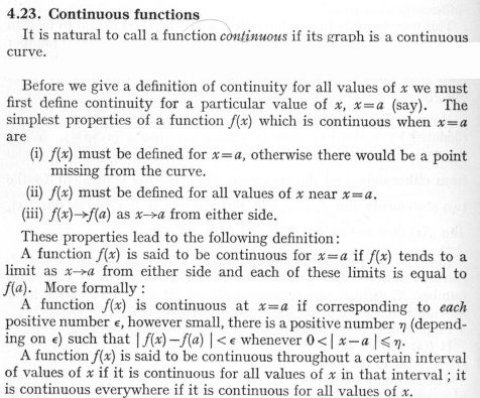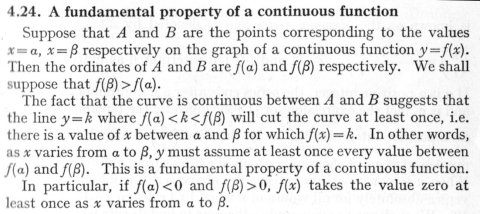Continuity
Analytical Geometry
Projective Geometry
Analytical geometry conflates number, size and equality,
with geometric elements.
with geometric elements.
Analytical geometry takes lines to be at least infinitely-dense sets of points distributed according to ordinates (which are numbers of equal units) in some “co-ordinate frame”, so that line-types are distinguished only by their ordinate-styles, i.e., by their equations. (A graph is thought of as the distribution of the actual points, “written” as a track - i.e., graphed - in actual space, as directed by the ordinate-style).
That is to say, they are distinguished numerically, not geometrically, on the (usually tacit) assumption that to every point, without exception, in a distribution, there corresponds a number, or numbers, as an ordinate, or ordinates, all referred to a co-ordinate frame.
This assumed, infinitely-dense association of values with points is deemed to confer “continuity” on distributions.
A so-called ‘function’, often written in some abstract form such as
y = f(x),
defines these ordinates, and can provide a selection of them in a list as ordinates for plotting purposes (i.e., "displaying" or graphing the distribution to some extent in actual space). The inverse procedure is usually supposed valid, especially in the sciences; that is, it is supposed that a limited selection of plottable numbers can successfully imply the full function, using methods roughly equivalent to the, “joining of dots”, sometimes found in children's' colouring books.
Accordingly, a “straight” line is merely a set of points distributed by a certain ordinate-style, equation or “function”, and a “curved” line is merely a set of points distributed by another, different ordinate-style, equation or function.
For Analytical geometry,
lines can either be curved or straight.
Indeed, a curve is said to be straight if it has “zero curvature”.
For projective geometry, none of this is the case.
Indeed, a curve is said to be straight if it has “zero curvature”.
For projective geometry, none of this is the case.
An account * of continuity as it is defined by analytical geometry appears below. Note that its opening sentence is projectively meaningless.
Rates of Change
Analytical geometry is often concerned with rates – that is, with how rapidly an ordinate of a distribution changes relative to another ordinate in the same distribution – and then the continuity of a distribution is entirely crucial for the quantitative determination of this rapidity.The rate is first expressed approximately as a ratio of two quantities, each of which is an arithmetical difference between two adjacent corresponding ordinates of the distribution —
If x1 and x2 are adjacent ordinates of a distribution described by y = f(x), (these ordinates are expected to graph spatially as the end-points of a ‘geometric’ interval), then the corresponding adjacent ordinates of the distribution are
y1 = f(x1) and y2 = f(x2),
and then the changes of these ordinates are, respectively,
δx = x2 - x1 and δy = y2 - y1,
where the symbol δ denotes that we are evaluating a change, or increment, of its associated ordinate.
Then the rate of change of the y-ordinate with respect to the x-ordinate near x1 is approximately evaluated as a ratio, δy/δx (‘approximately’, because the ratio represents the rate of change of a chord of the graph, not of the curve itself), on the assumption that the approximation will be improved by reducing δx.
We have, abstractly,
y = f(x)
if we change x, it should produce a corresponding change in y.
y + δy = f(x + δx)
Subtracting y from both sides, to preserve equality, we get
δy = f(x +δx) - f(x).
Dividing both sides (again to keep the equality) by δx, we obtain the ratio
δy/δx = (f(x +δx) - f(x)) / δx,
and we hope that this ratio does not disappear when, on test, we take
δx towards zero for some particular, non-abstract distribution,
but hope that it instead settles on a particular value,
for this should be our exact rate of change,
[putatively that of the tangent to the curve at ‘point’ (x1, y1)],
not an approximation to it represented by a chord.
In other words, we hope that δy/δx tends to a so-called limit
with the reduction of δx.
By way of an example, consider
y = f(x) = x2.
=> δy/δx = ((x + δx)2 - x2) / δx
=> δy/δx = 2x + δx.
Assuming that this distribution is numerically continuous,
then, because 2x clearly will not change as δx dwindles,
δy/δx must continuously (that is, without drop-out, break or deviation)
approach 2x, as δx approaches zero,
so, because of this assumed continuity,
we also assume that, “in the limit”,
δy/δx = dy/dx = 2x, exactly
Thus, the numerical continuity of the distribution is clearly crucial:
if a value for y is not found for a value of x,
then the rate of change cannot be evaluated for that x.
Now, in an important sense, irrational instances of y can be said not to exist, because, by definition, there are no units available to sum to them. They must represent discontinuities in distributions that feature them – if, for example, some y of the distribution happens to be the square root of 2 (which may be the most famous irrational of all!), y could not be plotted at all.
This should alert us to the possibility that algebras, which manipulate quantities in the first instance, not lines points and planes, may not in fact conflate properly with Geometry, even of the Euclidean sort.
Projective geometry does not conflate number, size and equality,
with geometric elements.
with geometric elements.
Projective geometric elements, simply because they are elements, are not composed of anything: for example, a line is not made of points—nor, as to that, is it made of line. A line is extension-as-such, pure and simple. It is not made of extension: it is extension.
Thus a curve is not a line, because a curve is a plurality; it is compound.. Because it is composite, it cannot be a geometric element. It is too rich.
It is rotation of a line
around a point,
as that point translates on that line.
as that point translates on that line.
A purely projective geometric means to render either the rotation or the translation continuous may not exist.
For detailed discussions in respect of this perhaps startling assertion, see
Limits, Absolutes(3), and the Circling Measure pages.

